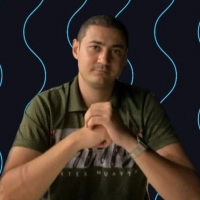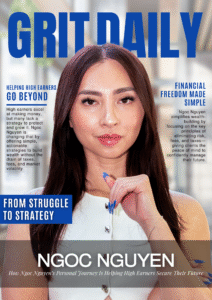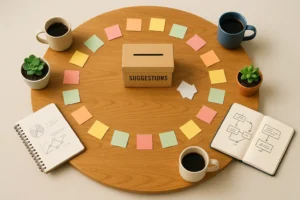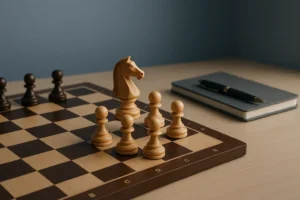In the fast-paced world of leadership, balancing personal development with team growth is a challenge that can make or break a career. Insights from a managing director, Fintech expert and a founder shed light on effective strategies. Discover the parallel-learning approach and the value of utilizing CliftonStrengths for team growth, among the thirteen expert insights featured. This Q&A blog post explores actionable methods to ensure leaders and their teams thrive together.
- Adopt the Parallel-Learning Approach
- Create a Culture of Continuous Learning
- Surround Yourself With Complementary Talent
- Implement the Learn-and-Teach Method
- Utilize Reverse Mentorship Program
- Practice Reflective Coaching
- Attend Workshops as a Team
- Initiate Skill-Swap Days
- Openly Share Your Journey
- Cultivate Team Autonomy
- Align Personal and Team Development
- Lead by Example and Delegate
- Utilize CliftonStrengths for Team Growth
Adopt the Parallel-Learning Approach
As a leader, striking a balance between personal development and fostering the growth of my team requires intentional time management and a commitment to leading by example. One strategy that has worked well for me is the “parallel-learning” approach. This involves setting personal-development goals that align with the skills or knowledge my team also needs to acquire. For instance, if I’m investing in learning about a new technology or leadership technique, I’ll organize team workshops or discussions around that same topic, creating a shared learning experience.
This approach allows me to grow personally while directly contributing to my team’s development. It fosters a culture of continuous learning where everyone, including the leader, is developing together. By encouraging open dialogue and knowledge-sharing, it not only strengthens my leadership skills but also builds a more cohesive, empowered, and capable team.
 Sergiy Fitsak
Sergiy Fitsak
Managing Director, Fintech Expert, Softjourn
Create a Culture of Continuous Learning
I balance my growth with the team’s by creating a culture of continuous learning. I allocate time for my personal development, such as staying updated on L&D trends, but I also empower my team to pursue their own development paths. One strategy that works well is cross-training, where team members learn different skill sets from each other, fostering both personal and team growth.
For example, after I completed a course on corporate training innovations, I encouraged my team to explore new methodologies and hosted an internal workshop to share what I learned. This not only boosted my knowledge but also allowed my team to expand their expertise. Lead by example and create a shared learning environment.
 Christopher Pappas
Christopher Pappas
Founder, eLearning Industry Inc
Surround Yourself With Complementary Talent
It might feel counterintuitive and even uncomfortable, but one of the biggest lessons I’ve learned about building a strong team is to surround yourself with people who are better than you in certain areas. Recognize your own strengths and weaknesses and seek out talent that complements those gaps. It’s tempting to fill a team with people who think like you, but that limits opportunities for growth, learning, and innovation.
A diverse team, with varied approaches and methods, creates endless opportunities for everyone to teach, challenge, and learn from each other. I often find myself in discussions where my instinct is to push back against a new idea, but embracing these different perspectives has shown me where I can grow and what new skills or knowledge I should pursue.
 Elyas Coutts
Elyas Coutts
CEO, Connect Vending
Implement the Learn-and-Teach Method
I’ve found that integrating personal and team development through a “learn-and-teach” approach has been highly effective. Each quarter, I commit to learning a new skill or concept that pushes me out of my comfort zone and aligns with the team’s goals. Once I’ve grasped it, I share that knowledge through workshops or presentations.
This method holds me accountable for my own growth and models continuous learning for the team. By showing vulnerability in my learning process, I create an environment where it’s okay to ask questions and embrace new challenges. Teaching deepens my understanding, and the team gains exposure to new ideas.
After the presentation, I assign practical mini-projects so everyone can apply the new knowledge. This strategy has fostered a culture of shared growth and curiosity, driving both personal and collective development.
 Sam Bahreini
Sam Bahreini
Founder & CEO, Konstellate
Utilize Reverse Mentorship Program
One effective strategy I’ve used to balance my personal development with fostering my team’s growth is implementing a “Reverse Mentorship Program.” In this program, junior team members mentor senior leaders, allowing us to learn from each other dynamically. For example, I paired with a younger team member who specializes in social media marketing. They taught me about the latest trends and techniques in digital marketing, while I shared insights from my own career experiences and lessons learned over the years.
This initiative doesn’t just keep me in the loop with fresh perspectives; it empowers our junior staff to step into leadership roles and shine in their expertise. It fosters an open dialogue where everyone feels valued and confident in sharing their insights, resulting in a dynamic culture of collaboration and mutual respect, where each team member contributes to the growth of the whole. This approach transforms learning into a shared journey, making us all better together!
 Beth Worthy
Beth Worthy
Cofounder and President, GMR Transcription Services, Inc.
Practice Reflective Coaching
In my role as a relationship counselor and owner of Colorado Relationship Recovery, I’ve learned the importance of striking a balance between personal development and nurturing my team’s growth. I strongly believe that personal development has a ripple effect on team growth — as I evolve, my team and the entire organization reap benefits. One strategy that has worked beautifully for me is “reflective coaching,” where I maintain an open dialog with team members about my own insights and learnings to foster their development.
For instance, completing my Level II PACT therapy certification enriched my knowledge and therapeutic skills, and I used this knowledge to develop an internal training program. This allowed me to not just enhance my capabilities but to also elevate my team’s skills. I often draw from my own learnings during team discussions, using personal experiences as teachable moments. Ultimately, I believe that by investing in personal growth and transparently sharing those insights, leaders can create an enriching environment that encourages collective growth.
 Jason Polk
Jason Polk
Owner, Colorado Relationship Recovery
Attend Workshops as a Team
As a leader, balancing personal development with the growth of your team is crucial for fostering a healthy work environment. One effective approach I’ve adopted is to incorporate team learning into my own development goals. By setting objectives that align with both my personal growth and the skills we want to enhance in the team, I create a win-win situation.
For instance, when I decide to attend a workshop or conference, I make it a point to bring team members along. This way, we can learn together, share insights, and discuss how to implement new strategies in our daily work. This not only enhances my own knowledge but also empowers my team by exposing them to fresh ideas and perspectives.
Another strategy is to create a culture of knowledge-sharing. I hold regular sessions where team members can present what they have learned from their own development efforts or external training. This encourages continuous learning and shows that I value their growth as much as my own.
By blending personal and team development, I foster an environment where everyone feels motivated to grow. It strengthens our collaboration and drives innovation, ultimately benefiting the entire organization. This balanced approach not only enhances my leadership skills but also cultivates a strong, capable team ready to tackle challenges together.
 Ramzy Humsi
Ramzy Humsi
Founder & CEO, Vortex Ranker
Initiate Skill-Swap Days
One unique approach I use to balance my development with my team’s growth is “Skill-Swap Days.” Each month, I share a new skill I’ve learned — like adaptive leadership techniques from a recent seminar — and each team member also presents something they’ve mastered. For example, last month, a developer showed us a faster debugging method, saving us time.
The real beauty of these sessions is that they are an exchange; we’re all learners and teachers. They are low-cost but incredibly high-impact, as each session gives us insights and actionable ideas without the need for formal training.
We get immediate, actionable insights without formal training, and everyone benefits by learning directly from each other. It’s a simple strategy that builds a culture of shared growth and keeps us evolving together.
 Brandon Bryler
Brandon Bryler
Chief Executive Officer, Coimobile
Openly Share Your Journey
Striking the balance between personal and team development is about realizing that your growth fuels your team’s growth. One approach that’s helped me is making personal development a part of my leadership approach through vulnerability and transparency. I openly share with my team what I’m working on — whether it’s developing better communication skills or learning a new framework. This openness not only holds me accountable but also creates a space where my team feels encouraged to take ownership of their development.
The strategy I follow is simple: model the growth mindset. If I’m actively developing myself, I show my team that growth is not a destination but a continuous process. I encourage them to take time for their own development, providing opportunities for training, mentorship, or even peer-to-peer coaching. When everyone is growing, we’re able to bring our best selves to the table — both individually and as a team. That’s when real transformation happens.
 Chase Friedman
Chase Friedman
Founder & Brand Coach, Vanquish Media Group
Cultivate Team Autonomy
I know this is super counter-intuitive, but time away from the business is always the best thing for me and my team. Whether I go on a solo trip to ground myself or head away for some family time to fill my cup, I find two things happen. I can reset and refocus on what’s important in or out of my business, and also my team is able to exercise some independence and autonomy without the feeling of someone watching them.
They really always rise to the occasion when I give them space to spread their wings. It’s incredible to see when I come back from a trip, and the team has maybe hit some speed bumps but gotten up and over them by using their initiative and company values to guide them.
 Maria Unali
Maria Unali
Founder, Salon KIIN
Align Personal and Team Development
I’ve found that the key to balancing personal and team development lies in intentional alignment between both. Personally, I invest in mindfulness and meditation to stay centered and lead with clarity, which directly influences how I support my team.
One approach I implement is incorporating mindfulness techniques, not just in my personal routine but also into our team’s culture. For example, regular moments of reflection during meetings encourage everyone to stay grounded and find balance in their roles. By fostering open communication, I ensure that while I continue to grow through self-care and personal development, I create space for my team to express their needs and goals.
Additionally, I make it a priority to lead by example and look to lead with a servant-based leadership approach. My personal development in meditation and mindfulness allows me to practice patience, active listening, and empathy — qualities that I strive to pass on to my team. Whether it’s through professional development opportunities or encouraging team members to find their own outlets for balance, I aim to build a supportive environment where we all grow together. It’s a process of duality where both personal and team growth are interwoven.
 Sylvia Ehle
Sylvia Ehle
Vice President, Continuing Medical Education
Lead by Example and Delegate
Don’t tell people what to do — show them by example. This is one of my core team-management strategies, as well as a key approach for their development. Setting an example is crucial. I ensure my team sees that I’m actively developing. Whether I’m attending courses or conferences to stay up-to-date with the latest trends, reading books, or seeking feedback from others, I demonstrate that I’m always learning. This sets the tone for the team and encourages them to adopt the same mindset. It’s about fostering a culture of continuous improvement, where learning is a constant, not just something done occasionally.
I’ve practiced a continuous-learning approach for many years, but I choose each opportunity carefully. Why do I need this course/book/podcast? Does it align with my personal goals? Do I have the time and resources to complete it? Answering these questions not only saves time and money but also helps me focus on what truly matters at the moment. I encourage this approach within my team as well. Knowing the purpose behind our actions and understanding what we’re working toward is one of the key questions I pose to each team member. In meetings and regular one-on-one sessions, we set short- and long-term goals, analyze our progress, and identify what we need to learn to exceed those goals and build effective plans for the future.
One of the fastest ways to teach someone is to give them the chance to practice. Yes, I’m talking about delegation. Gradually handing over tasks to teammates, patiently watching them make mistakes, helping them correct those mistakes, and then witnessing how they handle tasks on their own — sometimes even better than I did — is rewarding. This not only supports their growth but also frees me up to focus on my development.
 Daria Leshchenko
Daria Leshchenko
CEO and Managing Partner, SupportYourApp
Utilize CliftonStrengths for Team Growth
I took CliftonStrengths for my own personal development almost 20 years ago, and I realize now it was transformational for my career, and the businesses I led. It not only helped me recognize what I do best and how my strengths set me apart, but it also allowed me to better understand other people’s strengths and how to work more effectively as both a team member and leader. As I embarked on this journey, I became more aware of what motivated me and how I could use my strengths more intentionally, while staying mindful of where I needed to grow.
I brought this learning to my team and quickly realized how CliftonStrengths created a shared language to discuss strengths and weaknesses in a more objective and productive way. Since then, I’ve worked with thousands of teams — both as a leader and an Executive Coach — and the magic that happens when a team discovers their collective potential never gets old. When individuals understand their unique contributions and how they fit into the bigger picture, it transforms how they collaborate and perform.
Personal development only happens in relationship to others, and it isn’t just about learning new skills or staying ahead of trends; it’s about building self-awareness, resilience, and the ability to inspire that same commitment in your team — allowing them to inspire each other in return.
Investing in your development is a business strategy. Integrating it with your team is a business game-changer, and there is plenty of research and data to support this.
Kimberly Giddens
Executive Coach, Personologie








